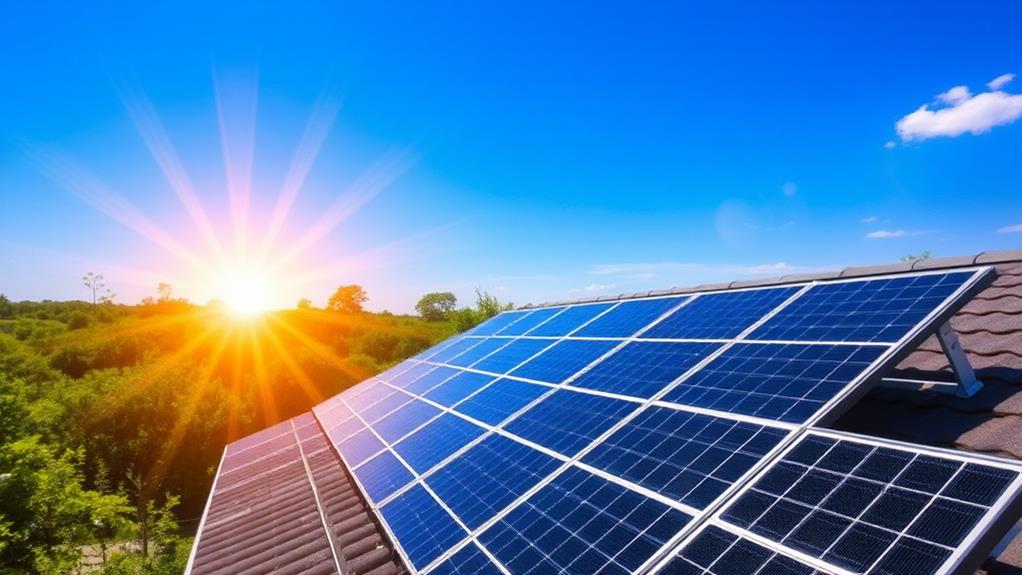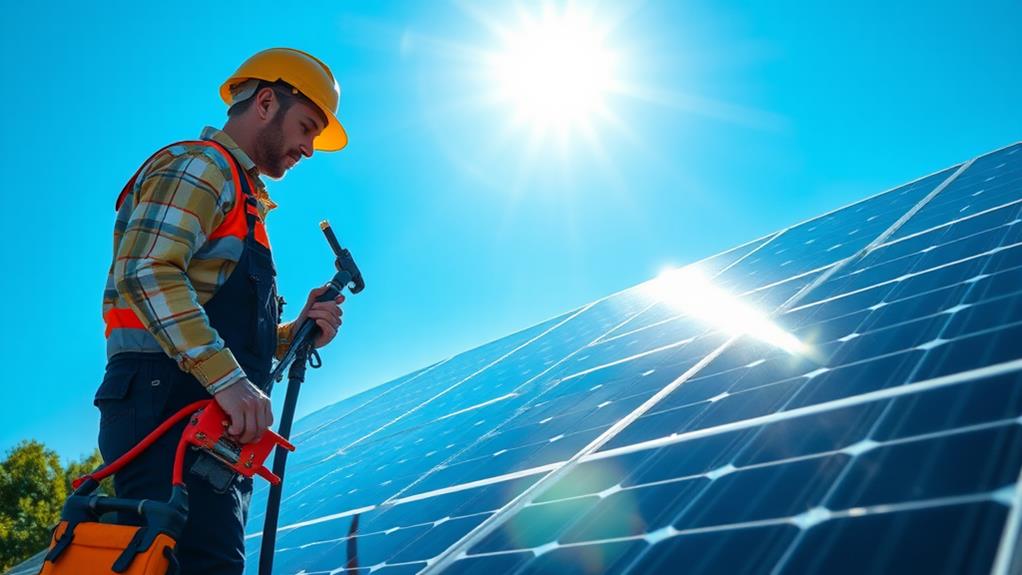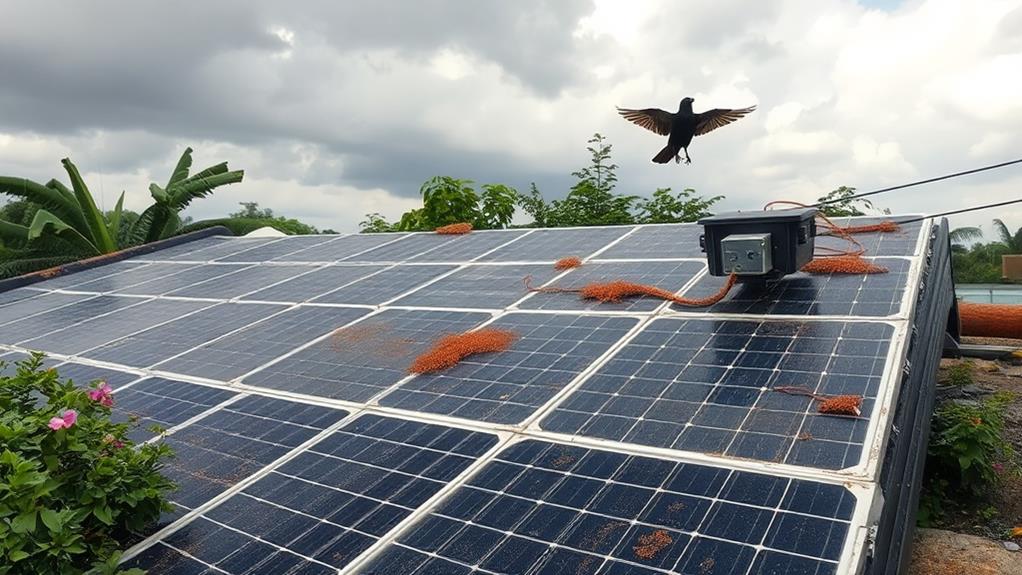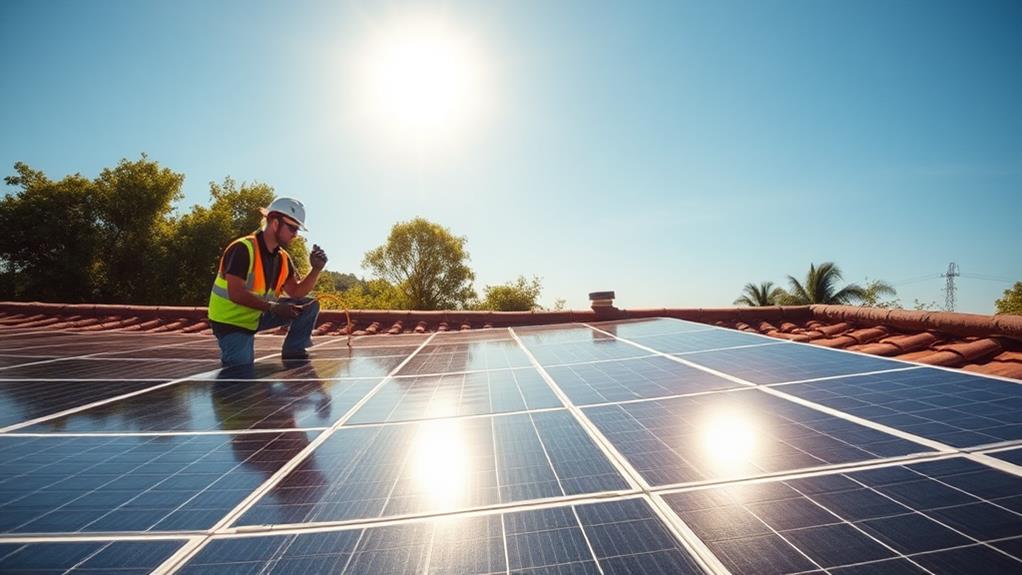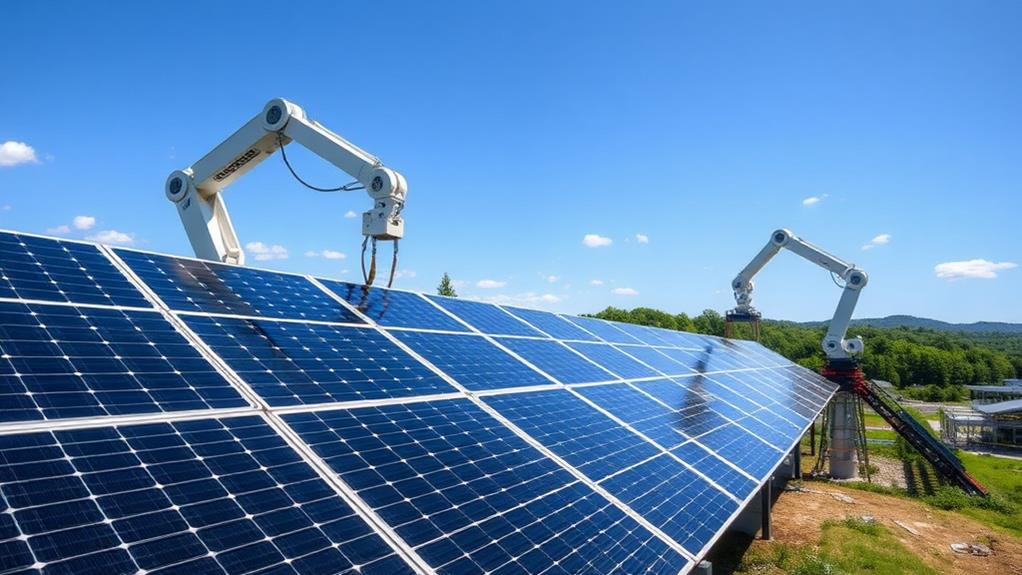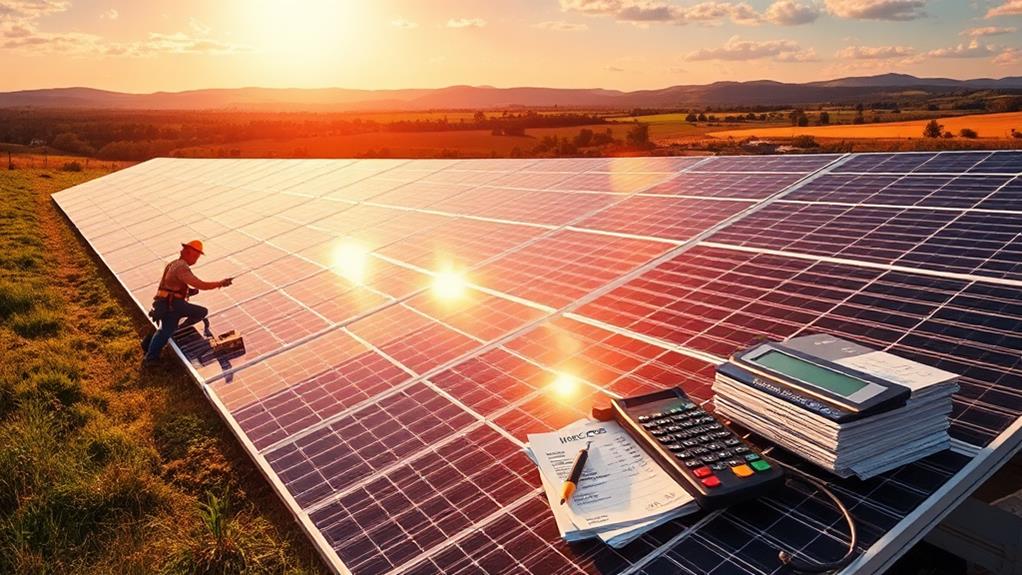When positioning solar panels, we should aim them southward to maximize energy production, adjusting the tilt to match our geographical latitude. This alignment harnesses optimal sunlight, especially significant as we approach the equator where panels should face directly upwards. Roof design, slope, and materials also impact efficiency, while ground-mounted panels, though more efficient, may not fit everyone's space requirements. Let's be sure to navigate local regulations and permits, as compliance with zoning laws is essential. Regular maintenance like cleaning and inspections increases output, ensuring long-term performance. As we investigate further, we'll uncover strategies for effective positioning and installation.
Key Takeaways
- Optimal solar panel direction is southward for maximum energy production; avoid northward-facing panels.
- Adjust tilt angle according to geographical latitude for enhanced energy efficiency.
- In South Africa, panels should face north or slightly east/west with a 25-30 degree tilt.
- Roof design and material significantly influence solar panel system efficiency and performance.
- Ground-mounted panels offer greater efficiency, while roof-mounted panels save land space.
Importance of Solar Panel Direction
When it comes to solar panel efficiency, the orientation they're facing truly makes a difference. As a community committed to sustainable energy, it's common knowledge that southward-facing solar panels in the northern hemisphere are our best option for maximising energy production. Positioning panels to face south ensures they absorb the most sunlight throughout the day, which is essential for generating the power required. Placing them at the ideal angle further enhances this effectiveness, optimising our solar initiatives as much as possible.
It is worth considering alternative orientations. While south-facing panels excel in energy production, westward-facing panels can also be beneficial, particularly during peak demand periods in the late afternoon. This can aid those striving to meet energy demands as the sun begins to set.
Northward-facing panels should be avoided, as they provide the lowest efficiency in producing solar energy.
Selecting the appropriate direction for solar panels enhances the capture of the sun's energy and contributes to a sustainable future. Making well-informed choices aligns with collective objectives for energy independence and environmental stewardship.
Optimal Angle for Maximum Efficiency
Understanding the significance of solar panel direction is vital, but the angle at which panels are installed is equally important. To achieve peak efficiency, focus on the optimal angle. The basic guideline is to align the tilt angle of solar panels with geographical latitude. This ensures panels are positioned to effectively capture the sun's rays throughout the year.
For those residing near the equator, solar panels should ideally be positioned to face directly upwards. As one moves towards the poles, it becomes necessary to tilt the panels towards the equator. This adjustment maximises energy production by allowing the sun's rays to strike the panels more directly.
Environmental factors such as snow in northern climates can impact performance. A lower tilt angle may lead to snow accumulation, reducing energy output. Adjusting the tilt to a steeper angle can help shed snow more effectively. Climate considerations highlight the importance of understanding local conditions to set the optimal angle and enhance the solar system's efficiency.
South Africa's Unique Solar Conditions
Let's investigate how South Africa's plentiful sunlight shapes our approach to solar panel positioning. By orienting panels towards the north or slightly east/west, we can harness the sun's energy most effectively all year round.
Considering the fluctuating sunlight patterns throughout the seasons, modifying the tilt angle to approximately 25 to 30 degrees guarantees we optimize energy generation and decrease carbon emissions.
Optimal Solar Orientation
When considering solar panel installation in South Africa, orientation is crucial. The ideal direction for solar panels in this region is typically north-facing. This position captures the abundant sunlight, maximising energy generation throughout the day. A north-facing orientation usually results in more direct sunlight, leading to efficient power production.
South-facing roofs shouldn't be completely disregarded. In certain areas where the sun's path varies, south-facing panels can still be beneficial. Understanding the local environment can help optimise energy generation.
East and west-facing panels can also be advantageous, capturing the morning or afternoon sun, which can align with specific energy consumption patterns.
For those looking to install solar panels, the Canadian Solar HiKu series and LG's NeON 2 range are excellent options. Both offer high efficiency and durability, tailored to harness the maximum sunlight possible.
It's important to assess individual needs and local conditions to determine the best setup. Consulting a local solar expert can provide valuable insights and ensure the solar system meets specific requirements.
Seasonal Sunlight Variability
South Africa enjoys exceptional solar conditions, providing an excellent opportunity for harnessing renewable energy due to its high levels of solar radiation throughout the year. Embracing sustainability, we've the chance to optimise our solar panel installations.
Understanding seasonal sunlight variability is crucial to maximising our solar potential. Although we receive more consistent sunlight than many regions, the sun's angle shifts with the seasons, influencing the optimal positioning of solar panels.
To efficiently capture solar energy, it's essential to adjust the angle and direction of solar panels according to the time of year. In South Africa, panels facing south are typically ideal due to the sun's trajectory. During winter, a steeper angle aids in capturing lower sun arcs. In summer, a flatter position enhances exposure to higher sun angles. Considering these seasonal shifts ensures that our solar panels generate the maximum possible energy.
We can take advantage of South Africa's distinctive solar climate. Proper solar panel placement, informed by an understanding of seasonal sunlight variability, enables us to maximise energy generation and contribute to a greener future.
Consider products like the LG NeON® 2 solar panels, known for their high efficiency, or the SunPower Maxeon 5 series, which offers excellent performance in varied conditions. These options can further boost energy production and sustainability efforts.
Roof Design and Material Impact
Roof design significantly affects the efficiency of solar panel systems. It's important to consider both the style and material of a roof prior to installation. The overarching aim is to efficiently harness solar energy, and understanding the role of roof design is crucial.
In the UK, most roofs have a slope of 30-40 degrees, which is ideal for solar panels. However, the type of roof material—whether it be asphalt shingles, metal, or tile—requires specific mounting considerations to ensure optimal performance.
Shading from nearby structures or vegetation can considerably reduce the efficiency of solar panels. Considering the type and slope of roofs enables better planning for an installation that maximises energy production. Ensuring solar panel systems are correctly positioned and oriented allows for peak performance.
For instance, if you have a metal roof, you may want to consider using thin-film solar panels like those from Solar Frontier, which are known for their flexibility and lightweight nature, making them suitable for metal surfaces. Alternatively, for tile roofs, SunPower panels could be a good choice due to their high efficiency and robust design.
Avoiding shading and choosing the right panel type and mounting system will help in achieving the best results.
Ground-Mounted Vs Roof-Mounted Panels
Choosing between ground-mounted and roof-mounted solar panels involves considering factors such as efficiency, space, and maintenance. As a community committed to sustainable living and energy independence, it's important to assess how each option aligns with our needs and property characteristics.
Ground-mounted panels, which can be positioned optimally for sun exposure, often surpass roof-mounted panels in terms of efficiency. Their adjustable angles allow us to harness more energy, which maximises our investment.
Roof-mounted panels are a favourite among many homeowners. They utilise existing roof space, preserving land for other purposes. This is particularly advantageous in urban areas where space is at a premium. However, limitations such as roof size, orientation, and potential shading from trees or nearby structures can affect their effectiveness.
Maintenance is another factor to consider. Ground-mounted panels offer easier access for cleaning and repairs, and they can accommodate larger systems if our energy needs increase. Ultimately, whether we choose ground-mounted or roof-mounted panels will depend on individual circumstances and preferences. Making a choice that best fits our community's goals will support our path towards a greener future.
Navigating Local Regulations and Permits
Before starting solar panel installation, it's crucial to navigate local regulations and permits to ensure compliance. This step aligns us with zoning laws and building codes, fostering community and responsibility. Understanding these rules allows us to promote sustainable energy while respecting our neighbours and local environment.
Local regulations can vary significantly, so researching any restrictions that might affect the placement of solar panels is essential. Some regions have specific guidelines about where panels can be installed, which might influence our choice between ground-mounted or roof-mounted solutions.
Consulting with local authorities can clarify any zoning restrictions relevant to our property.
Permits are another vital component. Securing the necessary permits before beginning installation helps avoid potential legal issues. This proactive approach not only ensures compliance but also provides peace of mind, confirming everything is done correctly.
Comprehending and adhering to local regulations and permits is fundamental to successful solar panel installation. This contributes positively to community sustainability goals and ensures smooth project progression.
Maintenance for Sustained Performance
To maintain our solar panels performing at their best, let's establish a regular cleaning routine using a soft brush or cloth to remove debris and dirt.
We should also set up a panel inspection schedule to catch any damage early and guarantee nothing is blocking sunlight, such as leaves or other obstructions.
If we're unsure about any aspect, professional maintenance services can help sustain our panels operating at peak efficiency.
Regular Cleaning Routine
Ensuring our solar panels receive regular cleaning is essential for maintaining performance and maximising energy output. As a community committed to sustainable energy, proactive measures are needed to ensure our solar investments continue to provide benefits. Regular cleaning is one of the simplest and most effective methods to enhance energy production.
Dust, debris, and other residues can accumulate, causing shading that interferes with sunlight absorption. A soft brush or cloth can gently remove these obstacles, allowing panels to function at peak efficiency.
Checking for any shading caused by leaves, branches, or other obstructions is important. We're all responsible for maintaining our solar panels to achieve our environmental objectives. Some may opt for self-cleaning, while others might consider professional maintenance services to ensure thorough cleaning and system longevity.
Companies such as SolarBright offer comprehensive cleaning services. Make regular cleaning a routine part of solar panel care, knowing that each effort contributes to a brighter, cleaner future for everyone.
Panel Inspection Schedule
Regular cleaning keeps our solar panels free from dirt and debris. However, maintaining peak performance necessitates a well-organised inspection schedule. Planning an inspection every 6-12 months ensures our system operates effectively and reliably. Solar investments must serve us well, and a consistent inspection routine is crucial to achieving that.
Inspecting our panels allows us to identify any issues early, such as shading from nearby structures or vegetation that can significantly impact energy efficiency.
Professional maintenance shouldn't be overlooked. Arranging annual professional maintenance permits experts to check for hidden damage or potential problems that might be missed. Their expertise ensures panels remain in excellent condition, preventing costly repairs later. It's akin to a friendly check-up for our solar companions, providing peace of mind.
Implementing a maintenance schedule is essential for prolonging the lifespan and efficiency of our solar panel system. Adhering to this schedule makes us part of a community that values sustainability and long-term performance. This guarantees that our solar panels continue to power our lives effectively and sustainably.
Obstruction Management Strategies
Obstruction management is essential for ensuring the sustained performance of our solar panels. We can ensure our solar investments continue to deliver maximum energy through proactive measures.
One initial step is regularly trimming trees or vegetation that might cast shadows on our panels. This simple action keeps sunlight streaming onto our panels, maintaining their optimal performance.
Cleaning is also important. Over time, dirt, leaves, or debris can accumulate on our panels, blocking sunlight and reducing efficiency. Adding panel cleaning to our maintenance routine will keep them free from these obstructions. It's crucial to remain vigilant for any new structures, such as buildings, that might block sunlight in the future.
Utilising shading analysis tools can help foresee and address potential obstructions. These tools identify areas where shadows might fall, allowing adjustments in panel placement or trimming of obstructions as needed.
A regular maintenance schedule aids in inspecting for new obstructions and addressing them promptly. Working together, we can ensure our solar panels perform efficiently and sustainably, benefiting both us and our community.
For effective cleaning, consider using a microfibre cloth and a gentle cleaning solution like Eco-Friendly Solar Panel Cleaner, which is available for approximately R150 in South Africa. This ensures the panels remain clear and unobstructed, optimising energy output.
Finding Professional Installation Services
When investing in solar energy, finding professional installation services is crucial to optimise efficiency and performance. As a community focused on sustainability, it's essential to ensure solar panels are installed correctly and positioned for maximum sunlight exposure.
Geo Green Power is a specialist in solar panel installations, offering services such as battery storage and EV charging to prepare systems for future needs.
Geo Green Power's commitment to quality is evident through their use of premium solar PV panels, which are backed by industry-leading guarantees. This assurance provides peace of mind, knowing the investment is safeguarded.
An initial step is to request a quote for solar PV installations and arrange a property assessment. This evaluation determines the optimal solar panel placement, ensuring the full potential of solar energy is harnessed.
Their expert advice on solar panel positioning and comprehensive installation services makes Geo Green Power a reliable partner in the journey towards renewable energy. Opting for professionals like them connects us to a network of environmentally conscious individuals dedicated to making a collective difference. Embrace the power of the sun with confidence!
Conclusion
When you're looking to harness solar power effectively, it's crucial to consider positioning and placement. By setting up panels at the right angle and taking into account South Africa's unique solar conditions, we can maximise the benefits. Whether you opt for ground-mounted or roof-mounted panels, it's important to follow local regulations and choose suitable materials. Regular maintenance ensures continued performance, and professional installation services can guide you through the process.
At Deo Solar, we are here to help you make informed decisions for a sustainable future. If you have any questions about our products, such as Rail-Less Solar Brackets, End Spacers, Structural Brackets, Ground Mounted Solar Systems, Corrugated Brackets, and Earthing Plates, please don't hesitate to reach out. We also offer services like the DeoSizer Tool, Evaluation and Design, Maintenance and Support, and Solar Installations. Contact us to learn how we can assist you!

